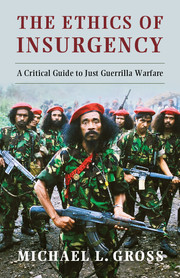Book contents
- Frontmatter
- Dedication
- Contents
- List of Tables
- Preface
- List of Abbreviations
- Map
- 1 Just Guerrilla Warfare
- Part I The Right to Fight
- Part II Hard War
- Part III Soft War
- 7 Terrorism and Cyberterrorism
- 8 Economic Warfare and the Economy of War
- 9 Public Diplomacy, Propaganda, and Media Warfare
- 10 Civil Disobedience and Nonviolent Resistance
- Part IV Concluding Remarks
- References
- Index
10 - Civil Disobedience and Nonviolent Resistance
Published online by Cambridge University Press: 18 December 2014
- Frontmatter
- Dedication
- Contents
- List of Tables
- Preface
- List of Abbreviations
- Map
- 1 Just Guerrilla Warfare
- Part I The Right to Fight
- Part II Hard War
- Part III Soft War
- 7 Terrorism and Cyberterrorism
- 8 Economic Warfare and the Economy of War
- 9 Public Diplomacy, Propaganda, and Media Warfare
- 10 Civil Disobedience and Nonviolent Resistance
- Part IV Concluding Remarks
- References
- Index
Summary
While this chapter comes at the end of the book, many might expect to see it at the beginning. Civil disobedience, demonstrations, and nonviolence are, after all, the first resort that we demand of disaffected groups before they turn to armed force. It is part of our preoccupation with terrorism, however, to condemn guerrilla movements for turning to violence before giving other avenues of redress a real chance. While this is only sometimes true, civil disobedience and nonviolent resistance remain an important, but overshadowed, tactic of struggles for national self-determination.
While nonviolent tactics often accompany armed force, they are usually the purview of an organization’s political wing. The IRA’s Sinn Fein, for example, organized demonstrations and hunger strikes but also campaigned for political office to promote the republican cause (English 2003:202–211, 224, 245). The electoral option is, of course, rare. Many insurgents do not fight democratic regimes, much less participate in their political processes during an armed struggle. Instead, the political wings of movements in East Timor, Kosovo, and the Western Sahara adopted nonviolent tactics, peaceful demonstrations, and diplomacy to augment their struggle for independence. In the late 1980s, the Palestinians waged a relatively nonviolent campaign against Israel during the first “Intifada” and, like the Kosovars, built an impressive shadow government of parallel social and educational institutions to replace those of Israel and Serbia respectively. Later, and in spite of recourse to terrorism, Palestinians could effectively initiate calls to boycott Israel and call on supporters to launch a 2010 blockade-breaking flotilla that was one of the most successful, although morally flawed, examples of civil disobedience in recent years.
- Type
- Chapter
- Information
- The Ethics of InsurgencyA Critical Guide to Just Guerrilla Warfare, pp. 240 - 268Publisher: Cambridge University PressPrint publication year: 2015
- 1
- Cited by



